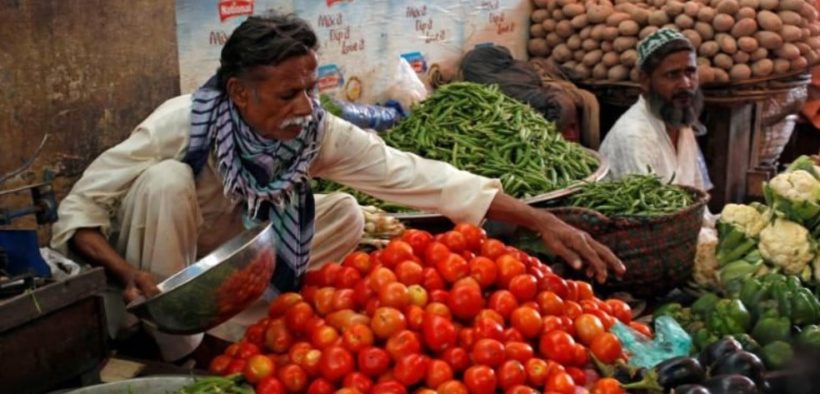Inflation in March drops to a two-year low of 20.7%

Despite a seasonal spike in perishable food prices, inflation in March dropped to an almost two-year low of 20.7%, exceeding government projections and casting doubt on the central bank’s decision to keep interest rates at historically high levels.
According to a Monday report from the Pakistan Bureau of Statistics (PBS), the rate of rise in prices for goods and services in comparison to the same month last year was 20.7% in March. In the previous 22 months, this rate was the lowest.
For the second month in a row, inflation decreased sharply, even considerably more than the optimistic government estimates. Additionally, it was the third month in a row that the rate of rise continued to decline.
The finance ministry had predicted last week that inflation would remain at around 23.5%. In metropolitan areas, where price increases were occurring at a far slower rate, the slowdown was more noticeable.
The central bank has kept the policy rate at 22%, the highest level since 1972, which is unreasonable given that the majority of Pakistan’s inflation is caused by artificial price increases or shocks to the country’s food supply.
Because interest rates are greater than the core inflation rate, the cost of borrowing for the government has climbed dramatically, reaching a record Rs8.3 trillion for this fiscal year.
At the most recent Monetary Policy Committee (MPC) meeting, the State Bank of Pakistan (SBP), despite the route indicating a decreasing trend and the core inflation rate being at ease, did not lower interest rates.
The International Monetary Fund (IMF) appears to be giving the SBP orders, as seen by the interest rate increases that have severely hurt both the government coffers and enterprise. In the second quarter of current fiscal year, the industrial sector shrank by 0.9% while the GDP increased by just 1%.
Because the central bank decided to buy dollars from the interbank in order to stabilize the foreign exchange reserves, the rupee-dollar parity also stayed at Rs 278.
Both the pace for food and energy products was slowing down, according to the PBS inflation bulletin, and this slowing down was observed in both rural and urban areas. In urban regions, the non-food inflation rate decreased to 25.8%, while in rural areas, it decreased to 21%.
The non-food inflation rate remained in the double digits due to transportation costs, gas, petrol, diesel, and power costs. The cost of electricity increased by over three-fourths while the price of gas increased by 318% over the previous year.
Pakistan has also promised the IMF to promptly raise the price of power. In an effort to collect an additional Rs100 billion from customers, including sales tax, the National Electric Power Regulatory Authority raised the price of power last week by Rs2.76 per unit.
In both urban and rural regions, the rate of food inflation decreased. According to the PBS, it slowed down to 16.6% in urban areas and to just over 17% in villages and towns. Because the cost of durable and necessary products has been rising by double digits every year, people’s purchasing power has decreased dramatically.
The tax burden has been greatly raised by succeeding governments. Due to a rise in the global markets, the government further raised the price of gasoline one day earlier by over Rs. 10 per liter.
The exchange rate has not changed, and because of the larger base impact, it is anticipated that the inflation rate would slow down even more in the upcoming months. Nonetheless, the government will fall short of its 21% annual average inflation objective.
After excluding energy and food costs, core inflation in urban areas decreased to 12.8%, the lowest level in over two years. In rural regions, it was found to be 20%. These days, the policy rate is much higher than the average core inflation.
Dr. Reza Baqir, the former governor of SBP, had previously agreed with the IMF that Pakistan will decouple the interest rate from the core indication and align it with the overall inflation rate. With the exception of tobacco and alcoholic drinks, all 12 groupings of commodities had double-digit price increases.
While non-perishable items had a 14% price rise, perishable goods saw a price increase of almost 42%. Due to the heightened demand during the holy month of Ramadan, retailers inflated the cost of fruits and vegetables.
The cost of fresh produce, including tomatoes, onions, and potatoes, as well as sugar, wheat flour, and pluses, increased significantly. However, the cost of cooking oil dropped by 22% in the previous month.
Once more, the government and central bank are expected to fall short of its 21% annual inflation target. According to the PBS, average inflation for the current fiscal year’s July–March period was 27.1%. This exceeded the declared goal of 21% for the current fiscal year by a significant margin.

I am a dedicated student currently in my seventh semester, pursuing a degree in International Relations. Alongside my academic pursuits, I am actively engaged in the professional field as a content writer at the Rangeinn website.








